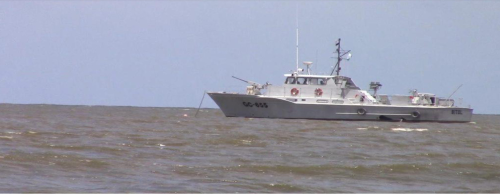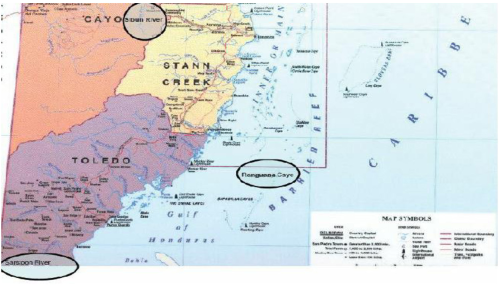
by Wellington C. Ramos
Wednesday, September 13, 2023
Belize is an independent nation that received its Independence from Great Britain on September 21, 1981. A resolution was brought to the United Nations Security Council and General Assembly for Belize’s Independence for other nations to support or not support the Independence of Belize. When the votes were taken in the UN General Assembly, 144 nations voted in support of Belize’s Independence and only one (1) Guatemala by itself voted against Belize’s Independence. Belize was then admitted as the 156th member State of the United Nations, with all its territory intact as was presented in the map of Belize as one of their credentials for Independence. Below is a map of Belize:

Before Belize was declared a British Colony in 1862, Great Britain signed Treaties with Mexico, Guatemala and Honduras to finalize the borders and boundaries between these three countries. Out of all the Treaties that were signed, the most significant Treaty was the Anglo-Guatemalan Treaty of 1859. In this Treaty, Guatemala conceded all the territory from the Sibun River to the Sarstoon River and to the western part of Belize.
Once a Treaty is signed by a country and land is conceded, the International Court of Justice (ICJ) take those Treaties seriously because of the land prescriptions that are contained in them. When the ICJ Court is deliberating territorial disputes among nations they take all that into account before deciding on a case. Below is the 1859 Treaty with Great Britain and Guatemala:
(AMANDALA Ed. Note: Due to space considerations, Articles 2 to 5 have been skipped, as they deal mostly with procedural matters. The underlining in Article 7 is by the writer.)
APPENDIX 1 CONVENTION BETWEEN HER MAJESTY AND THE REPUBLIC OF GUATEMALA, RELATIVE TO THE BOUNDARY OF BRITISH HONDURAS. Signed at Guatemala, April 30, 1859.
[Ratifications exchanged at Guatemala, September 12, 1859.] WHEREAS the boundary between Her Britannic Majesty’s settlement and possessions in the Bay of Honduras, and the territories of the Republic of Guatemala, has not yet been ascertained and marked out; Her Majesty the Queen of the United Kingdom of Great Britain and Ireland, and the Republic of Guatemala, being desirous, with a view to improve and perpetuate the friendly relations which happily subsist between the two countries, to define the boundary aforesaid, have resolved to conclude a Convention for that purpose, and have named as their Plenipotentiaries, that is to say:
Her Majesty the Queen of the United Kingdom of Great Britain and Ireland, Charles Lennox Wyke, Esquire, Her Britannic Majesty’s Chargé d’ Affaires to the Republic of Guatemala;
And his Excellency the President of the Republic of Guatemala, Don Pedro de Aycinema, Councillor of State, and Minister for Foreign Affairs; Who, after having communicated to each other their respective full powers, found in good and due form, have agreed upon and concluded the following Articles:-
ARTICLE I. It is agreed between Her Britannic Majesty and the Republic of Guatemala, that the boundary between the Republic and the British Settlement and Possessions in the Bay of Honduras, as they existed previous to and on the 1st day of January, 1850, and have continued to exist up to the present time, was, and is as follows:-
Beginning at the mouth of the River Sarstoon in the Bay of Honduras, and proceeding up the mid-channel thereof to Gracias á Dios Falls; then turning to the right and continuing by a line drawn direct from Gracias á Dios Falls to Garbutt’s Falls on the River Belize, and from Garbutt’s Falls due north until it strikes the Mexican frontier.
It is agreed and declared between the High Contracting Parties that all the territory to the north and east of the line of boundary above described, belongs to Her Britannic Majesty; and that all the territory to the south and west of the same belongs to the Republic of Guatemala…
ARTICLE VI. It is a further agreed that the channels in the water-line of boundary described in Article I of the present Convention, shall be equally free and open to the vessels and boats of both Parties; and that any islands which may be found therein shall belong to that Party on whose side of the main navigable channel they are situated.
ARTICLE VII. With the object of practically carrying out of the views set forth in the preamble of the present Convention, for improving and perpetuating the friendly relations which at present Convention, for improving and perpetuating the friendly relations which at present so happily exist between the two High Contracting Parties, they mutually agree conjointly to use their best efforts, by taking adequate means for establishing the easiest communication (either by means of a cart-road, or employing the rivers, or both united, according to the opinion of the surveying engineers), between the fittest place on the Atlantic Coast, near the settlement of Belize, and the capital of Guatemala; whereby the commerce of England on the one hand, and the material prosperity of the Republic on the other, cannot fail to be sensibly increased, at the same time that the limits of the two countries being now clearly defined, all further encroachments by either party on the territory of the other will be effectually checked and prevented for the future.
ARTICLE VIII. The present Convention shall be ratified, and the ratifications shall be exchanged at London or Guatemala as soon as possible within the space of six months. In witness whereof, the respective Plenipotentiaries have signed the same, and have affixed thereto the seals of their arms. Done at Guatemala, the thirtieth day of April, in the year one thousand eight hundred and fifty-nine.
(L.S.) CHARLES LENNOX WYKE. (L.S.) P. DE AYCINENA
xxxxxxxxxxxxxxxxxx
Since Guatemala signed the 1859 Treaty with Great Britain it has had problems with it. Whatever problems Guatemala has with the contents of the Treaty, they had more than enough time to bring the matter before the international court to seek redress from Great Britain whom they signed the Treaty with. Guatemala chose not to bring any case against Great Britain on any matter in the Treaty, and did not and will not sign any Treaty with Belize because they have refused to accept the Independence of Belize.
Recently, both Belize and Guatemala have agreed to refer the territorial dispute to the ICJ for a final resolution. Since the Independence of Belize, the Guatemalan troops have been engaging themselves in harassment tactics against the Belizean military and civilians from time to time.
A picture of a Guatemalan gun boat

This is the map of the area of Belize that Guatemala is claiming.

Most Belizeans, like myself, are sick and tired of hearing about the Guatemalan claim to Belize. Guatemala have more than enough land to give to their citizens so that they can improve their lives. Instead, they have been using their military to take away the lands of the indigenous Maya people, who have been fleeing to Belize for safety and to live a better life.
Because of the migration of Guatemalans (who are seeking refuge) into Belize, the southern part of Belize, which is the Toledo and Stann Creek Districts, have more Maya and Guatemalan citizens compared to Garifuna, East Indians and Creoles, who at one time were the majority of people in the south. The immigrants who migrated to Belize from Guatemala are not going back to their country to live because for these Guatemalan citizens Belize is a better place for them to live in peace than their country of birth.
The Government of Belize has the right to establish a military base on the Sarstoon because part of the area belongs to Belize as was agreed upon by Guatemala in the 1859 Treaty. Under International Law and in the United Nations Charter, no country or organization can tell Belize or any country what to do with their territory. It is left to the Government of every country to decide what they want to do with their lands and territories. The Government of Belize also has the right to bring a case against the Government of Guatemala, for their constant military harassments and intimidation with the use of their Armed Forces against the Belize Defence Force and Belizean citizens when moving freely on their soil. This year will make forty-two (42) years since Belize became an independent nation. Yet, the Government of Guatemala continues to refuse to accept Belize as an independent and sovereign nation.
Most nations in the world have already accepted Belize as an independent nation, so there is no reason for the Government and the citizens of Belize to wait for Guatemala’s acceptance. Let Belizeans now concentrate on building their nation for the future centuries to come. Concentrating on Guatemala’s claim and obstructionist tactics, will only instill fear in the Belizean people and nation to stifle development and growth.
Sooner rather than later, the Government of Guatemala will realize that they too must accept that the world has changed and is changing daily. Improving the quality of living for the citizens of each country, should always be all governments’ top priority agenda item including their government. For a country to spend a lot of time to acquire more land, when that country cannot take care of their current land and their citizens’ needs, is not productive.

